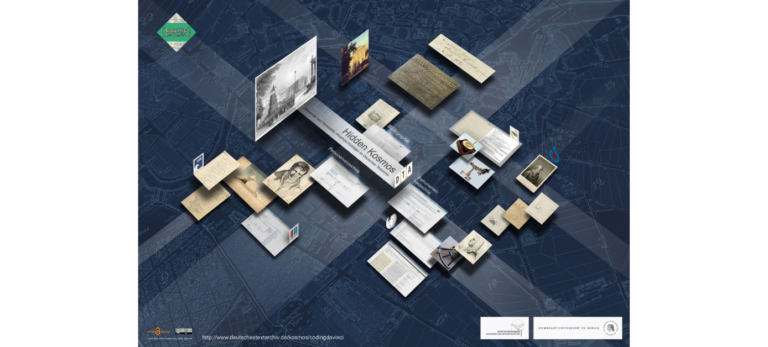
Das Hidden Kosmos – Reconstructing Alexander von Humboldt’s »Kosmos-Lectures« widmete sich von 2014–16 der Ermittlung und Verzeichnung, Bild- und Volltext-Digitalisierung
Short description of the project
CLARIAH-DE is the merger of the two research infrastructure networks CLARIN-D and DARIAH-DE. As part of the project, the two established research infrastructures were merged over two years (2019-2021).
Project content
CLARIAH-DE was a contribution to the digital research infrastructure for the humanities and related disciplines. By merging the CLARIN-D and DARIAH-DE consortia, CLARIAH-DE has created added value for researchers by further developing existing services along the FAIR principles of findability, accessibility, interoperability and reusability and making them jointly available. The portfolio includes the sustainable provision of research data, technical infrastructures, digital tools and virtual research environments for the humanities, information and training materials as well as handouts on standards and procedures.
The project was divided into six work packages:
AP 1 – Forschungsdaten, Standards und Verfahren
AP 2 – Werkzeuge und virtuelle Forschungsumgebungen
AP 3 – Kompetenzvermittlung und Nachwuchsförderung
AP 4 – Technische Vernetzung und Koordination der technischen Entwicklungen
AP 5 – Community-Engagement: Outreach/Dissemination und Liaison
AP 6 – Organisatorische Infrastruktur/Geschäftsstellen
CLARIAH-DE provides building blocks for a National Research Data Infrastructure (NFDI) and was an important pioneer of the NFDI consortium Text+ for language and text-based research data, which focuses in particular on digital collections and corpora, lexical resources and dictionaries as well as editions. CLARIAH-DE promotes the visibility, collaboration and networking of researchers in an international context and is part of the European Research Consortia (ERIC) CLARIN and DARIAH.
The implementation and development of CLARIAH-DE was ensured by the interlocking of strategic, operational and participatory committees. Together, the committees strike a balance between the technical infrastructure requirements and the research-driven needs of science. Overall coordination is the joint responsibility of the Göttingen State and University Library and the Eberhard Karls University of Tübingen.
The implementation and development of CLARIAH-DE was ensured by the interlocking of strategic, operational and participatory committees. Together, the committees strike a balance between the technical infrastructure requirements and the research-driven needs of science. Overall coordination is the joint responsibility of the Göttingen State and University Library and the Eberhard Karls University of Tübingen.
Twelve institutions are involved in merging the two research infrastructures CLARIN-D and DARIAH-DE in the joint project CLARIAH-DE: Chair of Media Informatics at Otto-Friedrich-University Bamberg, Berlin-Brandenburg Academy of Sciences and Humanities, Institute of Linguistics and Literature at TU Darmstadt, Gesellschaft für wissenschaftliche Datenverarbeitung mbH Göttingen, Göttingen State and University Library, Center for Language Corpora at the University of Hamburg, Institute of Computer Science - Dept. Automatic Language Processing at Leipzig University, Academy of Sciences and Literature Mainz (as subcontractor), Leibniz Institute for the German Language, Department of Computational Linguistics at Eberhard Karls University Tübingen, Herzog August Library (as subcontractor) and Chair of Computational Philology and Modern German Literary History at Julius-Maximilians-Universität Würzburg.
A further 13 institutions are involved in the continued operation of the infrastructures: German Archaeological Institute, Max Planck Institute for the History of Science, Max Weber Foundation - German Humanities Institutes Abroad, Salomon Ludwig Steinheim Institute for German-Jewish History, Forschungszentrum Jülich, Karlsruhe Institute of Technology, Leibniz Institute of European History, Herder Institute for Historical Research on East Central Europe, Bavarian Archive for Language Signals, Chair of English Language and Translation Studies at Saarland University, Institute for Natural Language Processing at the University of Stuttgart, Trier Center for Digital Humanities, and DAASI International GmbH.
Add your DH research project to the project showcase by submitting a short project description via the web form. Enter project data, a brief description, a graphic or visualization as well as a detailed description of the project content with technical assignment, addressees, added value, project managers, funding information and duration.

Das Hidden Kosmos – Reconstructing Alexander von Humboldt’s »Kosmos-Lectures« widmete sich von 2014–16 der Ermittlung und Verzeichnung, Bild- und Volltext-Digitalisierung
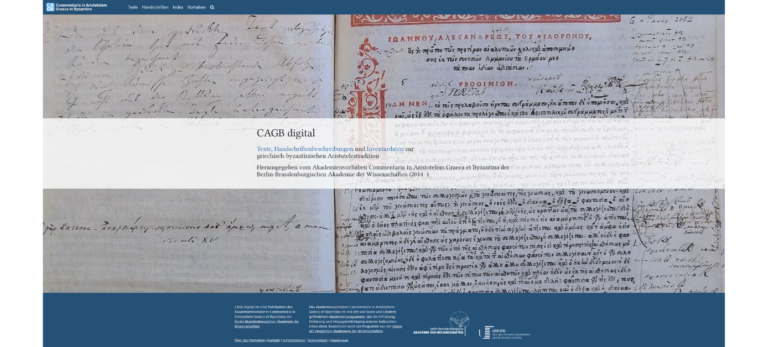
Das Akademienvorhaben hat die philologische Erschließung und kritische Edition antiker und byzantinischer Kommentare, Paraphrasen, Kompendien und Scholien zu den Schriften
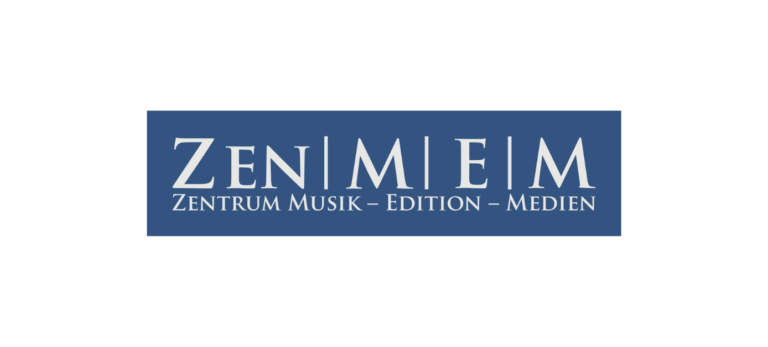
ZenMEM ist ein dezidiert offener Verbund von Wissenschaftler*innen und darum bemüht, gemeinsam neue, digital gestützte Forschungsmöglichkeiten im Bereich der Kulturwissenschaften
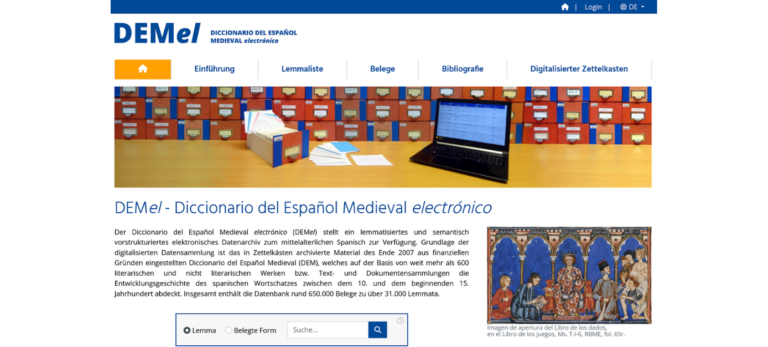
Das von der Deutschen Forschungsgemeinschaft geförderte Projekt Diccionario del Español Medieval electrónico (DEMel) hat zum Ziel, der Öffentlichkeit ein lemmatisiertes
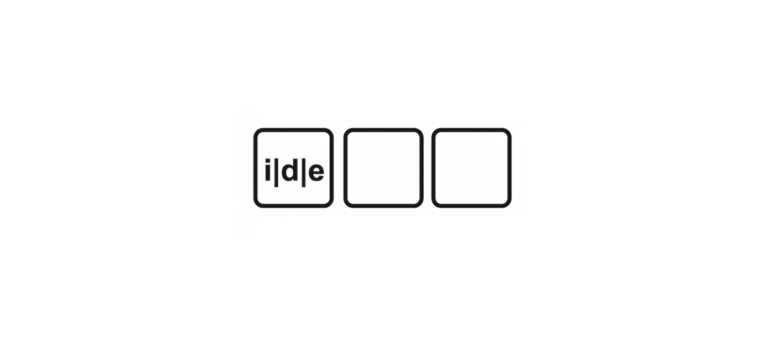
Das Institut für Dokumentologie und Editorik e.V. (IDE) ist ein internationaler Zusammenschluss von Wissenschaftlerinnen und Wissenschaftlern aus verschiedenen Disziplinen der
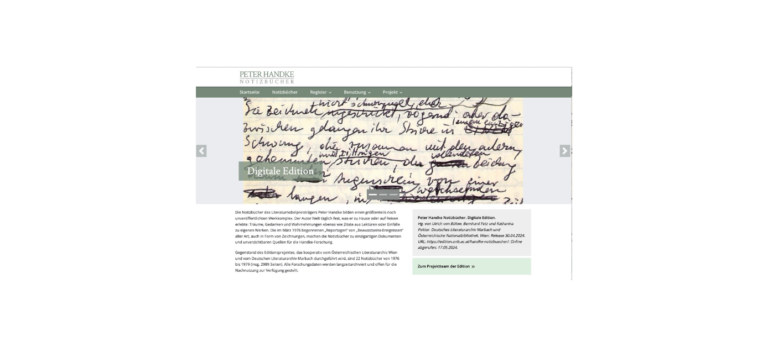
In einem langfristigen Kooperationsprojekt von Österreichischer Nationalbibliothek und Deutschem Literaturarchiv Marbach werden alle bis 1990 entstandenen 75 Notizbücher in einer

ELAN wird am Max-Planck-Institut für Psycholinguistik im Sprach-Archiv (TLA – The Language Archive) entwickelt. Es wird in der Programmiersprache Java geschrieben, die Quellen sind erhältlich für non-kommerzielle und kommerzielle Zwecken.

Das Hamburger Zentrum für Sprachkorpora berät und unterstützt bei der Erstellung und Nutzung digitaler Sprachkorpora in Forschung und Lehre: Es versteht sich als Kompetenzzentrum, das technische, methodische und organisatorische Expertise für die Arbeit mit Sprachkorpora aufbaut und bündelt.
Wir verwenden Cookies und ähnliche Funktionen zur Verarbeitung von Daten. Die Zustimmung ist freiwillig und kann jederzeit widerrufen werden.